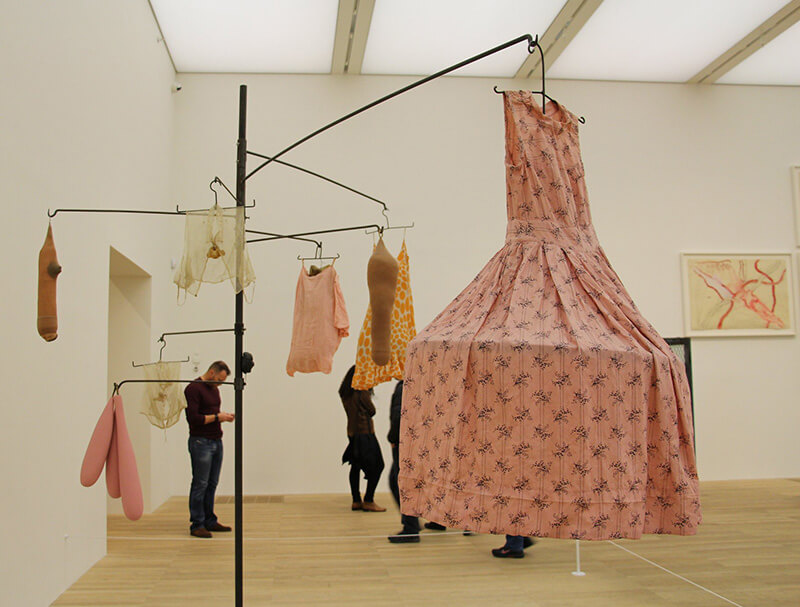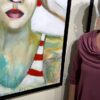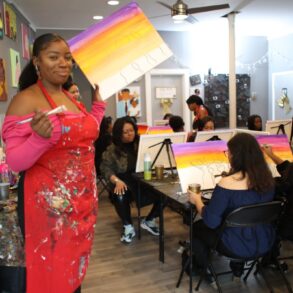
Parade by Rachel Cusk. Farrar, Straus and Giroux, 208 pages. 2024.
Rachel Cusk’s newest book, Parade, her nineteenth, is a startling, unconventional work of imagined biography. Divided into four distinct yet loosely associated chapters—part artist portraits, part fictions—the book traces the life of an artist named G, who lives many lives and is variously male and female throughout. One G is an old-guard German painter who, mid-career, begins to paint upside down. Another G paints ordinary scenes of women at home—breastfeeding, or half-glimpsed through a doorway; she also paints her husband, fully clothed, asleep in a chair. A third G sets off for a new life in a new country, where she wrestles with images of the female figure that she has inherited from men (she also marries a cruel and controlling husband). Then there’s a G whose large-scale sculptures of the female form include suspended knitted dolls and giant black spiders. The final G is a French filmmaker whose own mother dies without knowing her son is a world-famous auteur. Woven through these chapters are alternate strands of narration spoken by a different set of voices, sometimes an “I,” though more often a “we.” These narrators have little claim to identifiable personhood, and often speak with the same voice, whether in first or second person—impersonal, disembodied, cool and calibrated, given to flourishes of startling visual description.
According to its jacket copy, Parade is a novel: a work of fiction. But many of the artworks and artists that the character G is molded on are drawn from documentary sources, or “nonfiction objects,” as Cusk herself has termed them. These sources are not cited anywhere in the novel, but neither have they been effortfully concealed. So long as you are familiar with their works, the artists themselves are identifiable as real historical people, including Georg Baselitz, Louise Bourgeois, Paula Modersohn-Becker, Celia Paul, Norman Lewis, and Éric Rohmer. In Parade, they are all simply G and serve chiefly as repositories for Cusk’s aesthetic and philosophical concerns. They are her stand-ins, avatars, or doubles, if you will, repurposed in the novel to explore ideas of womanhood and art-making, the nature of self-representation, and female discontent within the bourgeois family. (She describes the heterosexual couple variously as a “two-headed monster” and as “creased and bleached” as the timeworn ornaments of a living room.)
Cusk’s mixing of fact and fiction is far-reaching and extends from the novel’s content to its form. Two sections of Parade were originally composed as nonfiction pieces: one began as a lecture on inversion in Baselitz’s paintings but was later published in The New Yorker as a short story; another, which considers Rohmer’s documentary-style films and the death of Cusk’s mother, was first published as an essay in Harper’s magazine. Then there is the feeling that Cusk’s narrators sound a lot like Cusk the critic, or Cusk the essayist, and that they find themselves in circumstances closely resembling Cusk’s own life. At one point, she even has a female novelist show up to G’s (or Baselitz’s) studio and brazenly declare that she wants to write upside down, an echo of the publisher’s description on the back of Parade, which states that “Rachel Cusk is a writer and visionary like no other, who turns language upside down to show us our world as it really is.” The truth claims produced by her use of nonfiction are constantly destabilized in the context of the novel.
Underlying such conceits is Cusk’s long-held suspicion of the novel form. At least since her acclaimed Outline trilogy, she has been insisting that “autobiography is increasingly the only form in all the arts. Description, character—these are dead or dying in reality as well as in art.” And yet her own ventures into autobiography—A Life’s Work and her divorce memoir, Aftermath—were pilloried by the press. On the one hand, Cusk was criticized for her harsh and unsentimental portrayals of early motherhood and marriage, and on other hand, her instinct for privacy was chastised as a form of manipulative withholding. The formal innovation of the trilogy, where the protagonist exists chiefly as a prism refracting other people’s stories of their own lives, was born in part as a response to this reception. Ever since, Cusk has been forging new strategies for putting experiences of the self—and the female self in particular—into novels, without directly confessing them or surrendering them to what she sees as the fundamentally bankrupt principles of narrative, an essentially “bourgeois enterprise, a gathering of substance from the world in order to turn it to the story’s own profit,” as she put it in an essay for the Times Literary Supplement on the Italian novelist Natalia Ginzburg. Mercifully, Cusk’s method does gather substance from the world—how bloodless would fiction be without it?—and, like any good writer, she indeed repurposes her findings—perhaps not for the advancement of conventional storytelling, but certainly to serve her own aesthetic aims, which have increasingly turned away from narrativizing an interior self in favor of a language, or a non-language, of external figuration that borrows liberally from the techniques of portraiture and painting.
The first time I read Parade, I wasn’t sure what to make of it. It seemed on the surface to lack the formal and thematic coherence of the Outline trilogy or even Cusk’s pandemic novel, Second Place. The sections, which all have different title headings—“The Stuntman,” “The Midwife,” “The Diver,” and “The Spy”—read as if stitched together from disparate, self-contained sources, lightly adjusted to fit inside the single framework of the book. I had read the excerpts in the New Yorker and Harper’s before my advance copy arrived, and tracing Cusk’s hand from one mode to another, how she edits and reworks, was disorienting; it seemed to somehow threaten the idea of the novel itself. The painter D became G; the filmmaker E also became G; other artists who had been cited by their real names were all G; a suicide in “The Diver”—the only section which reads like a callback to the earlier style of the trilogy—was now slyly anticipated in “The Stuntman,” the first and most compelling of the four chapters. But when I read the book again, the resonances across sections grew more pronounced.
One of the novel’s central thematic nerves is a violent incident, recounted by an unnamed woman, a writer who has moved to a new city—Paris—with a husband or partner. She tells us that the elements that used to define her—her country, her family, and even her children—now lie in the past: “My own history of motherhood feels like something far upriver, from which I’ve drifted a long way.” What has become apparent to her is “a lack of sequence or logic” in the unfolding of her life, a lack, we might say, of story. We learn that she has recently been hit over the head by another woman in the street, and that this attack, which left her “bleeding on my hands and knees,” has returned her to her body as a repository for female experiences that seem to operate outside language. “For the first time in years,” she tells us, “I thought about the violence of childbirth, when I had passed as if through a mirror into an inchoate, animal region, a place with no words.”
The attack precipitates a collapse of meaning and a complete reorientation of the connection between her mind and physical being: “The self and its preoccupations were shrunken and impotent, and the exterior plane with its prospects of imminent danger and disorder greatly enlarged.” The narrator begins to think of the perpetrator as both her “assassin” and her “stuntman”—“an alternate or double self” who exists to absorb and contain the expressions of her “biological femininity,” by which Cusk seems to mean those parts of herself that remain subordinate to male violence, vulnerable to both physical and emotional harm. The stuntman’s action acknowledges this prevalence of pain and domination in the successive stages of a woman’s life, and she reminds us that what we perceive as intrinsic to female character is tacitly circumscribed by the threat of violence and by the conditioning of her sex. As such, the stuntman is for Cusk the preeminent female artist, who continuously repeats and elaborates her performance (she has struck others in precisely the same place, and in a similar manner, we learn), knowing that pain cannot be assimilated or explained away by stories. Much like the female Gs in the novel—whose only recourse to representation, outside the malformed images produced by men, is through their own experiences and bodies—the stuntman uses herself as a subversive means of artistic expression: “Her body was the entire limit of her being and she had chosen to deploy her objectification,” our narrator observes. “She had done her work without making a sound. These were her offerings, the offerings of the stuntman: violence and silence.”
Parade is occupied not only with the work of artists but of other writers too. Cusk makes a direct reference to Camus’s L’Étranger in the final chapter, whose first line—“Not long ago our mother died”—echoes that novel’s famous opening (if parents in Parade aren’t already dead, they are soon dispatched to the nursing home). Then there’s W. G. Sebald, whose novel The Emigrants, with its four linked character portraits, reflects the structure of Cusk’s own. However, it is Virginia Woolf, and above all her revelatory essay “A Sketch of the Past,” whose ideas Cusk repeatedly references in the novel as a model for rethinking the relationship between language, perception, and the material world.
So much of life, Woolf argues in the essay, is made up of “non-being,” of the unconscious churn of domestic routine—what she calls the “cotton wool” of daily life. This has always been truer for women than it is for men; indeed, Cusk writes in response to one G’s paintings of ordinary, domestic scenes that the artist’s “point might have been that if one were to answer truthfully the question of what a female art might look like, it would have to be composed chiefly of a sort of non-existence.” Like this G, Parade seems to elevate the experience of “non-existence” to the primary principle of a female aesthetic, one that can only be conceived through a visual language of concrete images that surge out of the silence and murk of daily life. Images which contain, as Woolf writes, the “sudden” and “violent shock” of experiences that arrive like “the sledge-hammer force of the blow . . . a token of some real thing behind appearances.”
In Parade, the blows of experience are both figurative and literal: the attack on the street; midwives of death, who live on a lush and secluded island and perform their calling with “a single hammer blow to the head” when they perceive that a person has reached the end; the suicide flashing across sections; parents who die off, leaving their children with a sense of loss and liberation. Sometimes, characters are shocked out of themselves and into new states of being: “With him gone, I immediately found that I no longer needed to play the part of myself. Perhaps I no longer need to exist at all,” muses one character at a group dinner. There are also the aesthetic shocks produced by various Gs. A museum director in “The Diver” likens the suicide of a visitor to the show she has curated to “the power of disturbance in G’s work.” And when Baselitz’s wife first sees her husband’s upside-down painting, she feels as though she has been “hit.” At times, parallels proliferate to the point that you feel you, too, are being struck over the head.
But as the reach of death grows perhaps a little too palpable, life shimmers into view, radiant and resplendent. Most striking and pleasurable is the novel’s juxtaposition of a quite abstracted philosophical language with rich, pulsing, sumptuous, almost hallucinatory passages describing objects, artworks, and also, especially, nature. Attention is lavished on a cherry tree with branches “so ancient and so heavy that they rested all around it on the ground”: “In the sudden sunshine of the premature spring the tree had blossomed and given forth a startling white foam of flowers like the breaking of an enormous wave.” In another passage, G’s wife looks out of a window at an artist’s residency, noticing that “birds flit joyfully from tree to lawn and the flowers seem almost to lift up their heads and silently sing in the radiance.” Simultaneously, she sees a family “erupt onto the lawn,” and it is as if her own experiences of motherhood “are instantly illuminated”; in fact, they become so present to her that “they bypass memory and hint at actual recurrence.”
In its almost total ceding of storytelling, Parade can feel like a radical departure both from the Outline trilogy and Second Place, even as it shares the former’s rejection of character and narrative and the latter’s interest in the gendered process of art-making. What links Parade across sections is not a narrative as conventionally understood, not plot certainly, nor character, but rather a series of images. It is a work of intricate patterning—the kind that Woolf speaks of in her essay, a hidden pattern “that we—I mean all human beings—are connected with”—and it seems to require a new kind of attunement on the part of the reader, an attunement to moments and motifs so indelible to most women’s lives that they go beyond individual experience, repeating themselves mutely across time.
“How could the female sex be commemorated in stone?” Cusk writes in response to the cloth figures of the very Bourgeois-like G. “Its basis lies in repetition without permanence. Its elements are unlasting yet eternal in their recurrence, as violence itself is.” Reading Parade, I thought of another work by Bourgeois not mentioned in the novel, a 2009 textile piece entitled Self-Portrait. A twenty-four-hour clock hangs on the wall, and at each hour are images of defining events from the artists’s life, revealing, in chronological order, her own often painful trajectory through the various stages of femininity, from the early blossoming of youth to the more burdened and constricting roles of wife and, later, mother. As the dial turns, these phases of life begin to vanish behind her and then loom back into view. At the top of the clock sits Bourgeois’s iconic spider woman; its body, Cusk notes, “dooms it to utility,” to the kind of “women’s work” that goes unacknowledged and unseen: housekeeping, childrearing, and above all the perpetuation of a life that caters to the freedoms and liberties of men.
Cusk’s work has provoked derision and scorn for its refusal to accept as universal those things that are handed down to us through stories; she has even been deemed the cruelest novelist at work today. Yet Parade betrays a different writer, someone who isn’t only bent on destruction but who recovers shards of beauty from an already broken world; a writer who believes in the transformative power of art, so that “everything that is denied and suppressed in femininity, everything that remains darkly continuous behind its volcanic cycles of change and yet is unknown” can find a way into the light.







